Boat Profile

O’Day Day Sailer
A proven performer for 61 years
From Issue Small Boats Annual 2020 July 2019
T he production of small boats was booming in the 1950s on both sides of the Atlantic, and really took off in the late ’50s with the introduction of fiberglass. Famed designers Uffa Fox and George O’Day teamed up in 1956 to create the O’Day Day Sailer. Fox is credited with introducing the technique of planing to dinghy racing and designed many significant classes of boats, including the International 14. The story goes that Fox wanted a pure racing dinghy but O’Day wanted the small cuddy added to increase appeal to the recreational market in the U.S., so Fox designed the planing hull and O’Day designed the cuddy. The resulting Day Sailer was a 16’9” centerboarder with a displacement of 575 lbs, which makes for a light load to tow behind the family car. The fractional sloop rig includes a generously sized spinnaker for exciting downwind sailing.
The first Day Sailer was sold in 1958 and immediately became popular in the recreational and racing markets. It was later designated as the Day Sailer I as four different models have since been built, with over 10,000 boats hitting the waterways. Day Sailer (DS) models I through III have been built by eight different manufacturers, with the current Day Sailer being a modified DS I with a few DS II attributes, such as the internal foam flotation and cuddy thwart. The original DS models I, II, and III were built from 1957 to 1990 by the O’Day Company in Fall River, Massachusetts. The DS I and modified versions of it were later built by Can-AM Sailcraft, Rebel, Spindrift, Precision, McLaughlin, Sunfish/Laser Inc. The current builder of the DS I+ is the Cape Cod Shipbuilding Company (CCSC) in Wareham, Massachusetts, holder of the exclusive license since 1994. The Day Sailer Class Association owns the molds that are currently used by CCSC.
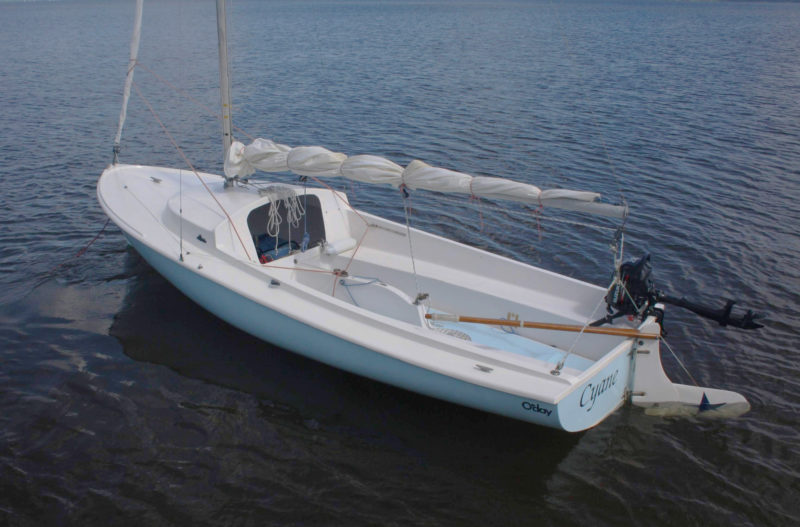
The long side benches in the cockpit provide uncrowded seating for six. The sole is above the waterline and is self-bailing.
The early DS I can be identified by wooden thwarts, seats, and cockpit sole, a centerboard lever, open cuddy, and a transom deck. The DS II came out in 1971 with built-in foam flotation. The cuddy opening is smaller than the opening on the DS I because it also acts as a thwart, and a thinner transom allows mounting a small outboard motor without the need for a bracket. The Day Sailer I and II are considered class legal for one design racing, but the DS III is not considered race-legal due to higher freeboard on the transom, which was a departure from Fox’s hull design. O’Day built the III from 1985 to 1990, so to race in One Design regattas it is important to buy a DS I or DS II. The current Day Sailer in production is a modified version of the DS I with improved self-rescuing capabilities, two sealed air tanks, and a cuddy flotation tank with a smaller hatch.
The Day Sailer, no matter which model, is a very versatile boat, easy to rig, sail, transport, and store. With the mast down the boat and trailer take up just a few feet more than an average family car, so can be stored in most garages, though the mast may need to be stowed diagonally. At the ramp, the Day Sailer can be rigged in under 30 minutes: step the mast, add the boom, bend on the jib and main, clip the pop-up rudder onto the transom, and sort out the sheets.
Stepping the mast is the biggest challenge. The 23′4″-long racing mast is stepped through the top of the cabin onto the maststep fixed to the floor of the cuddy, and that can be tricky for one person. The mast does not weigh much, but it is helpful to have a helper at the foot of the mast to guide it into the cuddy opening. The good news with this arrangement is that once the mast is stepped, it is secure, and there’s no rush to attach the forestay.
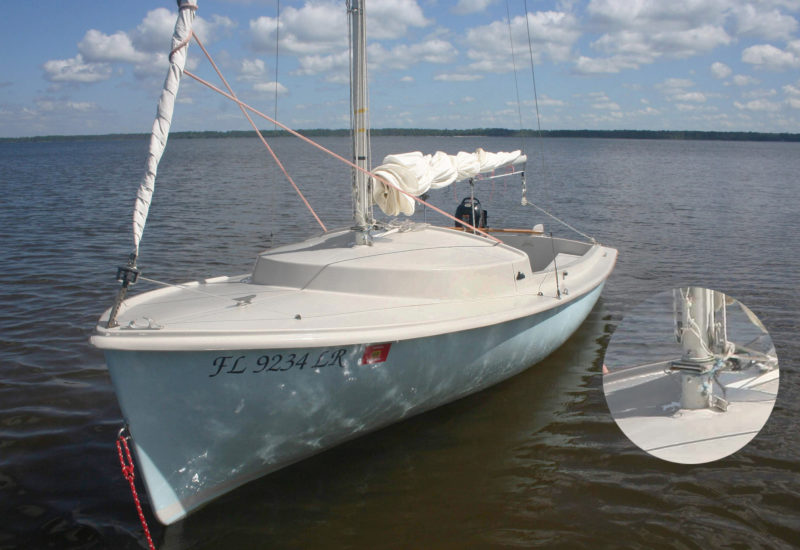
A mast hinge, a popular option, makes raising the mast much easier.
About 75 percent of the new boats are delivered with a hinged mast, eliminating the awkward gymnastics of stabbing the mast through the cuddy. Once the mast is raised and the forward hole on the hinge pinned, securing the forestay to the bow fitting takes the strain off the hinge. Side stays can then be tightened to take out the slack, but no more than hand tight. Stays that are too tight can damage the hull. Tighten the nuts on the turnbuckles and tape over any cotter pins.
There are different sheeting arrangements for the boom. Some boats have sheets attached in the middle of the boom; the sheet on a DS II starts from a traveler on the transom and ends forward on a swivel cam cleat mounted to the centerboard case. The DS II boom also has a spring in the gooseneck that allowed for roller furling— disconnect the sheet, pull the boom aft, and roll the sail onto the boom. A reefing claw has to be added to connect the sheet to the sail-wrapped boom, but this design is not optimum, nor is the wad of rolled-up sail by the boom’s gooseneck. A better arrangement is to add a conventional set of reefpoints to the mainsail. The boom also has a vang to improve sail control.
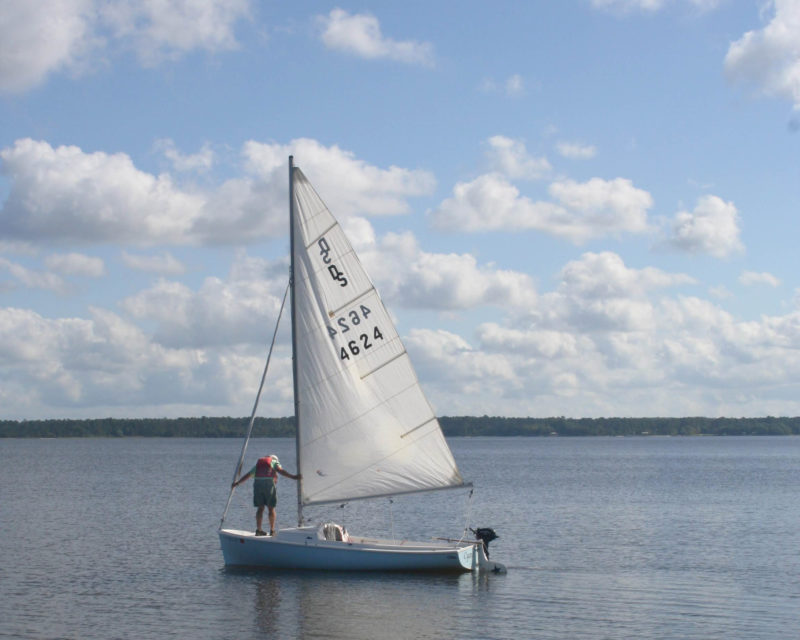
The 6′ 3″ beam gives the Day Sailer good stability, enough to keep the boat under someone standing on the foredeck.
The jib on the racing version of the DS is a standard affair, attached with hanks onto the forestay and raised with a halyard. Some skippers add a downhaul to lower the jib from the cockpit. Both the main and jib halyards are led aft on the top of the cuddy. The recreational version of the new DS I comes with a roller-furling jib, which we consider essential for sailing dinghies, especially if singlehanding. We have added a roller-furling jib to our DS II along with the mast hinge. We also added the hardware and rigging for a spinnaker, halyard, spinnaker pole, spinnaker pole control lines, sheet blocks, and jam cleats.
T he Day Sailer is a treat to sail; it handles well, tacks with ease, and powers up quickly with its large sail area. The planing hull is responsive to the tiller, and the wide beam makes it stable. The boat will roll quickly but then sets on a tack, holding it with stable and positive helm control. The centerboard can be easily adjusted from amidships.
We sail a Drascombe Lugger and a Sunfish; the Lugger drives like the family sedan and the Sunfish like our Mustang. The Day Sailer handling is closer to that of the Sunfish—when the breeze picks up, the mainsheet needs to be held in the hand and someone should be ready on the jibsheets. The jibsheets run through the coaming on the DS I and through small cars on the DS II. For the highest performance, skippers have added tiller extensions and hiking straps. There is an outhaul on the battened main; racing versions have barber-haulers and travelers added. Pop the spinnaker, and it will scoot along quite nicely in a light breeze.
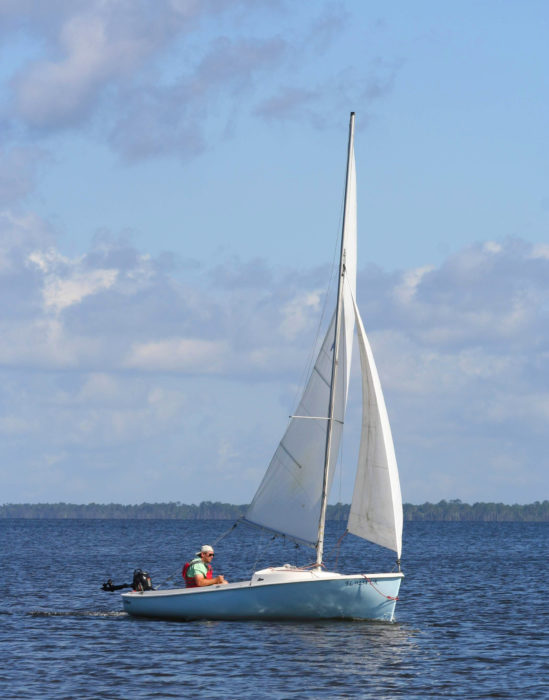
The Day Sailer carries 100 sq ft in the main, 45 sq ft in the jib and, for sailing off the wind, another 95 sq ft in spinnaker.
The Day Sailer’s 7′ 4″-long cockpit provides plenty of room for three adults, or two adults and two kids. With four adults it gets cozy; there is not much moving around, so whoever is sitting next to the tiller or foredeck needs to know what to do. It is easy to depower the main, reef it, or furl the jib as needed.
The cuddy is spacious for storing picnic or camping gear, and it affords a space equivalent to a two-person backpacker tent for sleeping aboard for overnight cruising. Adding a topping lift makes the boom nice ridgepole for a boom tent; there’s plenty of room to sleep in the uncluttered cockpit. The Day Sailer has completed many endurance cruising events, such as the Texas 200, Florida 120, and the Everglades Challenge.
A small kicker can be added for auxiliary power. We have used both an electric trolling motor and gas outboard, with best results coming from a 2-1/2-hp four-stroke that pushed push the boat to 6 knots at one-third throttle. The DS I will require a bracket to support and outboard; the DS II transom is thin and sturdy enough for a direct mount. If we’re not going far from home, we occasionally skip the outboard and carry a paddle; with her low coaming we have paddled her a bit, even backward over the transom.
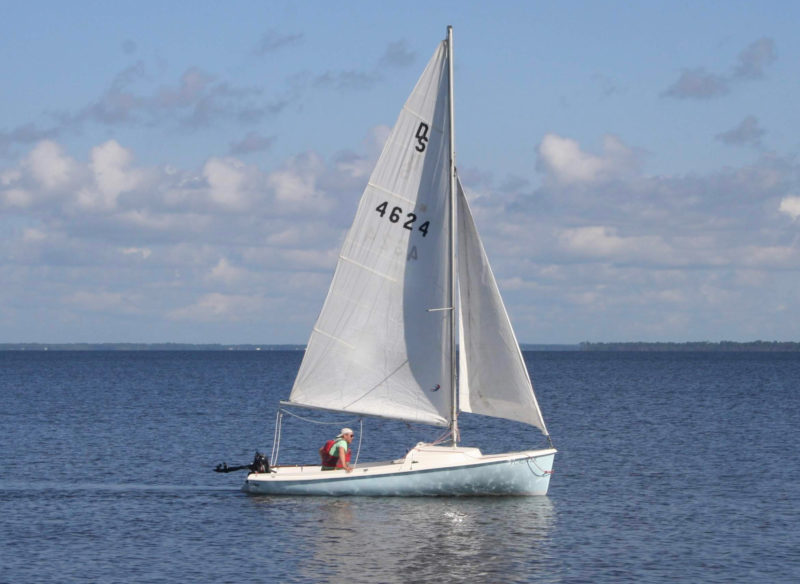
The transom of the Day Sailer II will accommodate an outboard for auxiliary power. The Day Sailer I will require a bracket.
D ay Sailers are easy to find and inexpensive, considering their capabilities. If you come across one, there are few important things to check. Make sure the centerboard moves in the trunk, see that the forestay tang and bow seam are not pulled up, inspect the cuddy deck for noticeable depression which would indicate failure of the maststep under the cuddy floor, and if it is a DS II look inside the flotation compartments. Rinse her off and get her ready to sail. There is a great Day Sailer Association with a web-based forum, and excellent parts availability.
Audrey and Kent Lewis enjoy time with CYANE, along with their small fleet of kayaks, canoe, sailboats, and lapstrake runabout. They blog about their adventures on smallboatrestoration.blogspot.com
Day Sailer Particulars
Length/16′ 9″
Draft, board up/9″
Draft, board down/3′ 9″
Displacement/575 lbs
Main/100 sq ft
Jib/45 sq ft
Spinnaker/96 sq ft
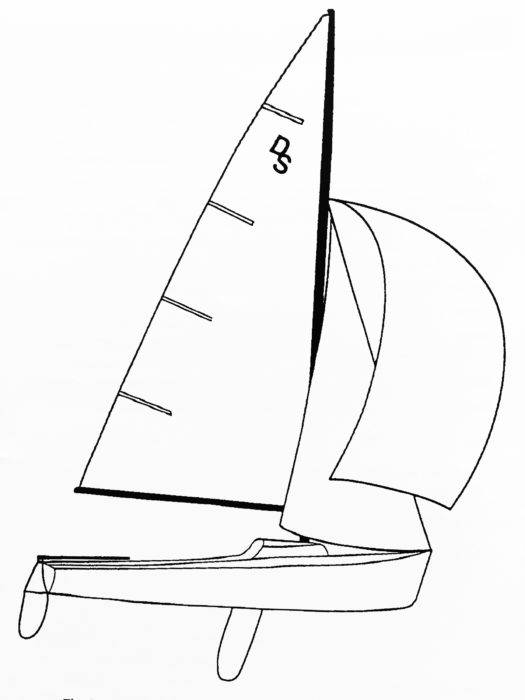
The Day Sailer is built by Cape Cod Shipbuilding Company . Prices start at $18,335 (less sails). For more information about the Day Sailer Class, visit the Day Sailer Association .
Is there a boat you’d like to know more about? Have you built one that you think other Small Boats Monthly readers would enjoy? Please email us!
Share this article
Join The Conversation
We welcome your comments about this article. If you’d like to include a photo or a video with your comment, please email the file or link.
Comments (37)
Great article Kent! I have a sister to your boat, right down to the racing mast and blue hull!! But since we’re moving to the Pacific NW, I’m about to sell it. I’m limiting myself to only 3 boats for the move (and it’s a hard sorting out!!!!). Great write-up about a fantastic boat! Thanks! Charlie
My father was George O’Day. It is nice to know the basic design that my Dad helped create is still vibrant 60 years later. I always find it interesting since Dad was a pure racing sailor that he designed a boat and saw the importance of appealing to the recreational aspect of sailing. He wanted to open the door to the bigger audience to share his passion of sailing.
I sailed with your father on a Hobie 16 at a Red Cross small craft instructor program. So much fun sailing with a legend.
Charlie we know it’s hard, the Day Sailer is such a timeless boat. If she has to change skippers, find her a good one.
Miss Beth, so wonderful to hear from a family member, it must have been quite an adventure to grow up around boating and racing. That Day Sailer hull was Cap’n Jack’s favorite, we enjoyed looking at it. Thank you for the insight into your family’s history.
Cheers, Skipper and Clark
I’ve had an O’Day for years, my first sailboat. I love sailing her around our little lake.
This boat is the best for a small family. In Brazil it’s a great option.
O’Day DS was my first brand-new boat. I was a “veteran”of maybe six months sailing in the late 1960s and she taught me to love sailing.
Great boat design. I’ve sailed different ones on and off over the years. Still a favorite.
Beth, your father made great boats as my father still has an O’Day 20 he bought new in ’76 and it’s still like new and a great sailing boat!
I recently bought a 1966 model after downsizing from a Viking 28. My father owned a Rhodes 19 and we sailed that boat for years on the western end of Lake Ontario. The design was similar, so the transition to the 16 was easy. I love the boat because even in high winds I can make a simple adjustment to the main with reef points. Solo sailing is fun and safe. I can see why so many were sold.
Hello, I just bought O’day sailboat. I do believe from what I’ve been reading that it’s a Daysailer 1. I was told this boat has never been registered and never had a kicker motor on it, I can’t find the metal tag on the transom but I see the two rivet holes where it should have been. Is there any other place on this boat to find the serial number? I would like to put a kicker on it and register it and, if not, is there a way to register this boat? Thank you for helping
The requirements to register a small boat that has not been registered before is different for each state. In NY, a boat is registered through the DMV. HIN numbers are placed on the right side of the transom. If you do not have one your boat was made prior to 1972.
Thank you for the reply, I’m working on getting a HIN number now.
Check with O’Day. Some manufacturers hide a second HIN onboard. Worth a shot.
My boat has a plate on the inside toward the front of the boat. On the bulkhead (might not be the right term) behind the mast. You’ll have to crawl into the cubby to see it. It’s a little plate 2″ x 4″ and shows Hull no. and Class no. The paperwork I have says the boat was made in 1967. Does anyone know the difference between Hull number and Class number?
Can anyone give me today’s value of a 1960 O’Day Day Sailer, #333, with a small motor that goes on the mount with sails that all sit on a Dilly trailer? It has all the original woodwork that my husband redid. It does not have a spinnaker but has the jib and main and a Proctor mast.
My daughter and I are looking for an older (less expensive) sailboat. Not sure where your at , we are South of Boston. The O’Day is our first choice. If you are going sell, please reply to this comment. Thanks
[I’ll connect sellers to John. Ed.]
16′ O’Day Day Sailor with trailer and motor
2013 DS for sale in Sharon,MA. needs work on floatation tanks
At 30 years old, I just bought my first sailboat which is a 1965 DS I. The boat has sat for a few years and she needed a good power-washing plus painting of the hull and inside the cubby and several new lines. I’m completely inexperienced with sailing (plenty of time cleaning boats, though) and couldn’t be happier to learn on such a beautiful vessel. Thanks for this article! It’s great to get some background info. Plus, plenty of words to highlight as I expand my boating vocab.
Day Sailers are easy to find? I guess you know where to look (certainly no offers in Craigslist). I have not been lucky enough to come across a good one that is 10 to 20 years old. I live in Massachusetts. Would you mind sharing where to look for one?
I have an O’Day day sailer 16.5 ‘ up for the taking. Our family had years of good times sailing and camping with It. Great family boat. Wooden seats and rails. Needs some work. In central Massachusetts
I am assuming you have gotten rid of your O’Day day sailer – if not, I may be interested. I’m new to sailing at 57 years young! I just took lessons at KYC here in Blue Hill, ME and am looking for a great starter boat that I can learn in and have fun on the bay.
Thanks, Kelly
Actually, I just bought a 1989 DS2 from Craigslist, on trailer, for $300. It needs only minor work and a lot of cleaning. I hope to float it Saturday to see if it sinks like a rock (I know it has flotation), and will need glass work, but I could see nothing amiss while on the trailer.
So, never say never.
Hi Laranja, I just read your comment about trying to find a used O’Day Day Sailer. I live in Wareham where Cape Cod Shipbuilding is located, they are the current builders of the Day Sailer. They usually have used boats available. I have a 1971 DS, a wonderful boat.
I have a 2013 DS for sale in Sharon,MA. needs work on floatation tanks
Fantastic article
Interested in purchasing a fine example that was actively sailed
I agree with the many positive comments above. Great article! I was a longtime owner of an O’Day Widgeon (14′), and after many boat-less years I’m pleased to have purchased a 1984 O’Day Daysailer II just last week. It’s in good condition, and after sourcing a few needed part, I’ll enjoy it on lakes here in Georgia. Thanks for the great article, which has served as an orientation of sorts for me as to what to expect when I launch her for her maiden voyage under my ownership. A long-time marketing and sales executive, I’m naming her SAILS CALL!
I just got a DaySailer, thought it was a 67 DS1 but the transom is thick with a box on the port side by the transom so not sure now DSII?
I just today bought and brought home to MA a 1966 O’Day Day Sailer (as shown on the registration from NH), and it has a thick transom with lidded box on the port side. Also has a wide cuddly opening and wooden cowling and thwarts as described above for a DSI.
We’re down sizing from a 53′ Pearson to an O’Day 18 that someone offered us. I have no qualms about the sailing, but the temperature of the water here (Massachusetts to Connecticut) worries me very much, after a lifetime in the tropics. Are these dry boats when sailed conservatively?
I have a 2013 Cape Cod built DS for sale in MA. Needs some work on floatation tanks.
I just sold our Venturer 22 and picked up (rescued) an O’Day 16 DS. A couple weeks in the shop and it looks ready to sail. One question: the roller reefed main (boom) does not “lock in.” I suppose I could jiffy reef it but does anyone have experience with the roller reefing boom? Am I missing a part (the claw) or do I just not get it.
I want to buy an O’Day sail 17′
We have a 1976, 17′ foot O’Day DSll (?) on trailer that we are transferring to another family member. We are trying to figure out the best way to get it from Oregon to New Hampshire. Any ideas out there?
Great article. My only question is we’ve had the 69 O’day Javelin in the family since gramps bought it new but it always seemed too easy to get into trouble with and the one time we turned it over on a very windy day. It was nearly impossible to right back up without a lot of help. So I’m wondering if the DAYSAILER is a much better and more stable boat and more forgivable. There certainly are more of them around too. Thanks, Ed on Long Beach Island at the Jersey shore
Kent/Audrey,
What trailer make and model do you use for your DS?
Thanks, John in VA Beach
Leave a Reply Cancel reply
Your email address will not be published. Required fields are marked *
Stay On Course
More From This Issue
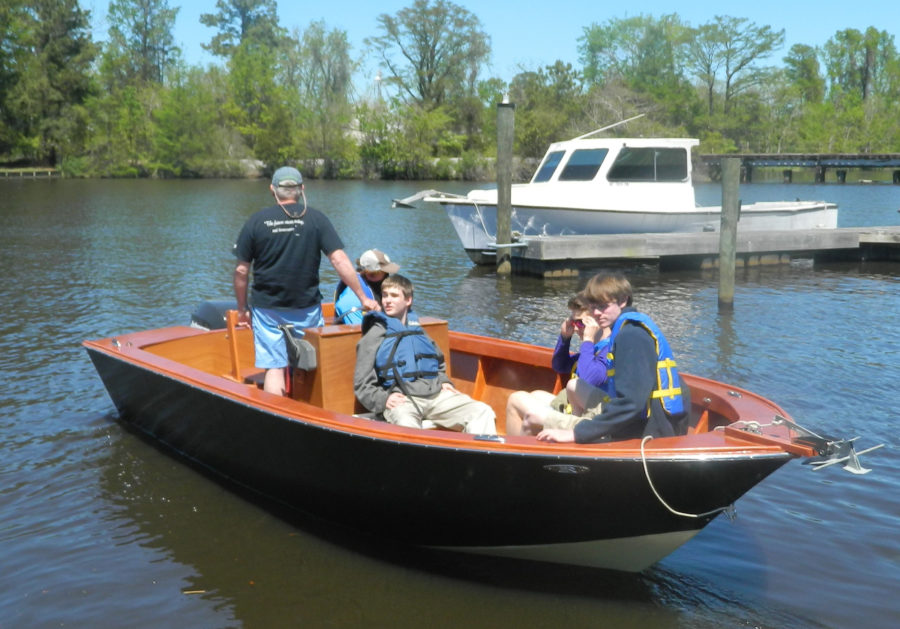
Reader Built Boats
The Kingfisher Elective
Glenn’s class at JPII is now among the most popular electives, and he has twice as many students as he had at home. That’s 10 students, a healthy percentage of…

The Day Sailer, no matter which model, is a very versatile boat, easy to rig, sail, transport, and store. With the mast down the boat and trailer take up just…

Ed Monk Skiff
Ed Monk was a famous Seattle-based Bryant’s Marina was a local yard that outfitted fishing vessels, and this skiff was likely a working tender for these vessels that could be…
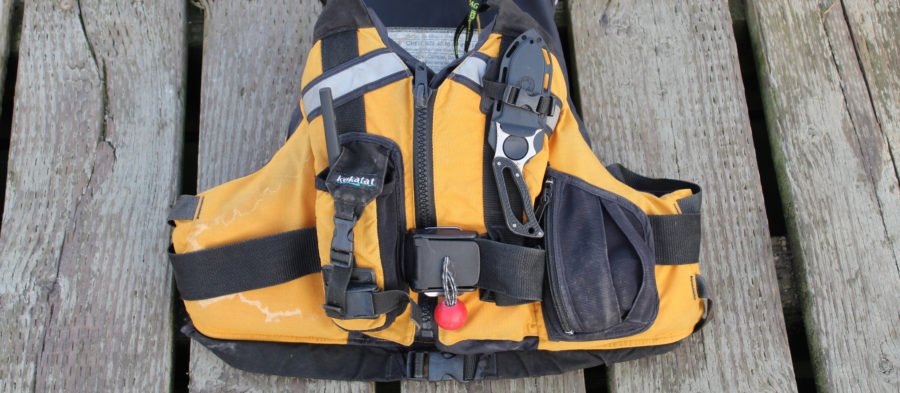
From The Editor
What’s in your PFD pockets?
The PFD I’ve been using for the past several years is the Guide model from Kōkatat. It does much more than keep me afloat. It has a top-loading electronics pocket…

One of the better-known trailerable boats in Southcentral Alaska is the Tolman skiff. Designed by the late Renn Tolman of Homer, Alaska, in the early 1990s, the three models of…

The Cosine Wherry
The Cosine Wherry is 14′ 2″ long with a beam of 52″ and should weigh about 100 lbs when built to the plans. It is strip-planked with 1/4″ x 3/4″…
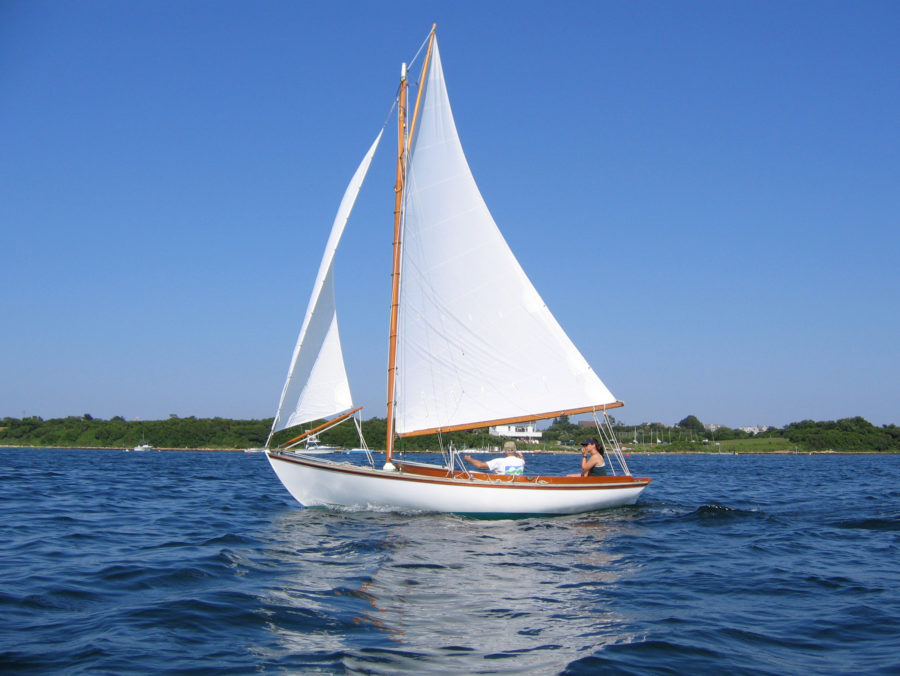
Although Carl Kaufmann made his career in journalism, his education was in naval architecture and marine engineering. So, he drew up his Block Island 19, a centerboarder with an overall…

Belle Daysailer
After I saw the photograph in the calendar, I searched up BELLE and found that Dan Gonneau, the designer/builder, had written a blog post that was a stream-of-consciousness diary about…

Parker Dinghy
Having had my sights set on building a plank-on-frame rowboat in the 12′ to 16′ range, I was immediately sold on the Parker Dinghy when I saw her lines. I…

A Superior Circumnavigation
By 6 a.m. we were slipping across exceptionally glassy water, paddling in silence. The water felt frictionless. The shore was lined with cliffs, with homes perched on the ledges high…
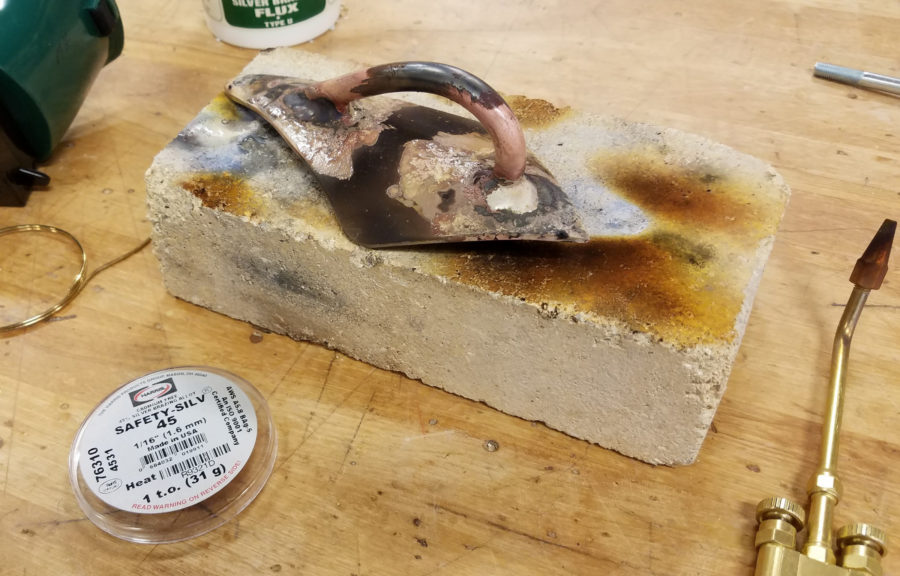
Fillet Brazing for Custom Boat Hardware
By using a brazing alloy that would build up in fillets at the intersections, the resulting radiused transitions would have the appearance of custom-cast fittings. After some experimentation with different…
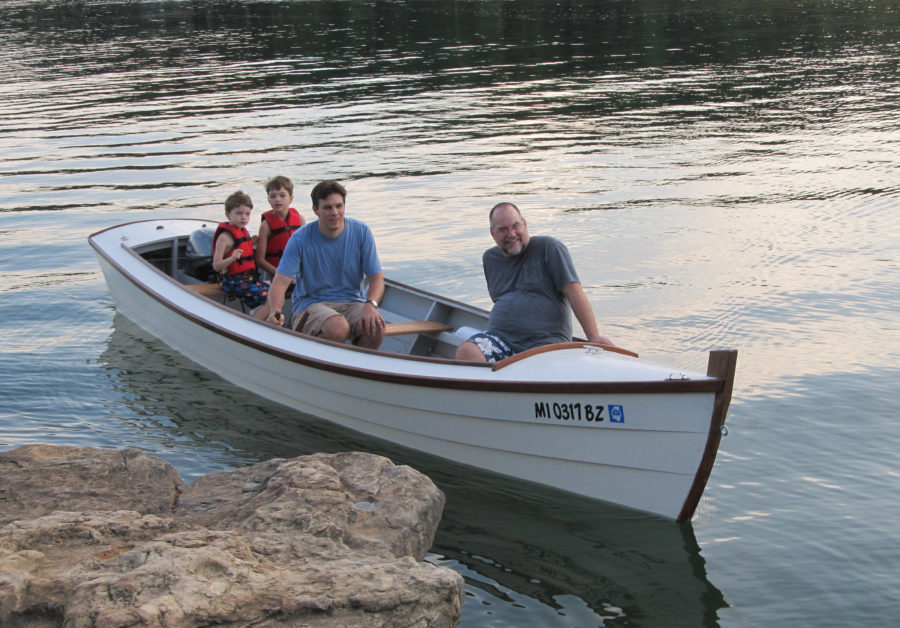
Flat-Bottomed Skiff HERON
Nick set his sights on a larger version of OTTER, long and slender, easily driven, capable of cruising at 10 knots while carrying 600 lbs. He enlisted his father, who…
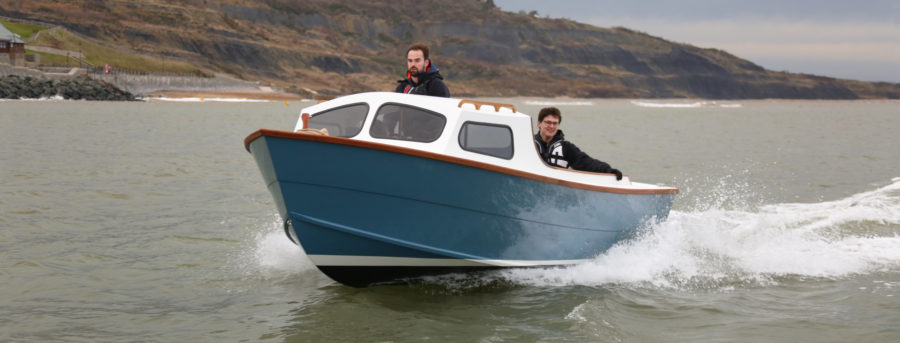
On the day SADIE was launched, the wind was light and there was a slight chop off Lyme Regis. With five of us on board and the engine at 5,000…
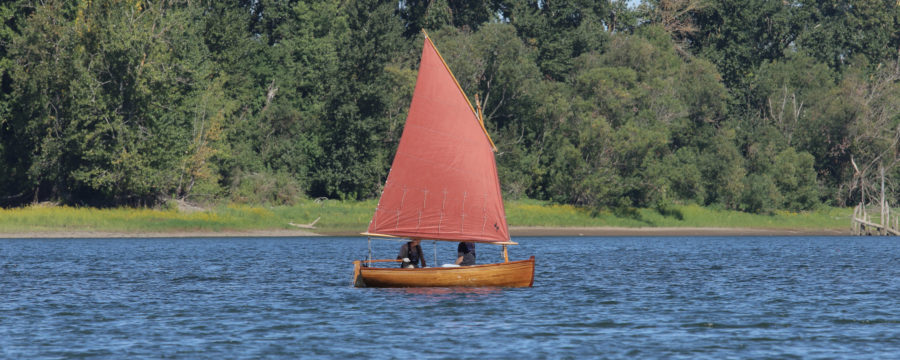
I contacted François Vivier in the fall of 2016 to inquire if his Morbic 12, designed for lapstrake plywood, could be built with strip planks. He replied, “Yes, with some…
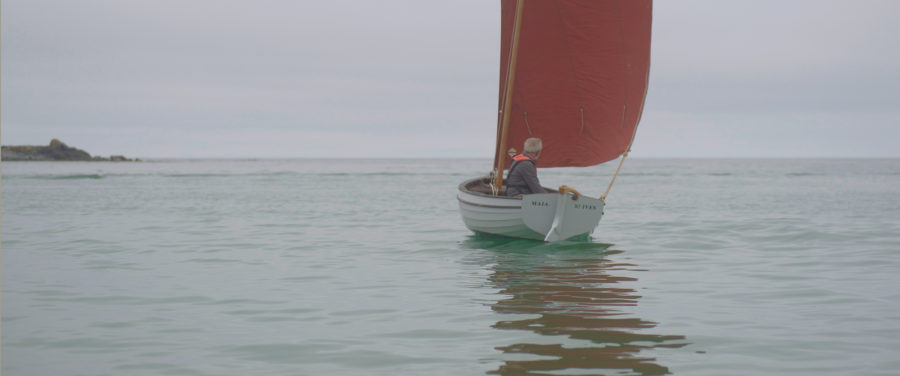
St. Ives Punt
Jonny built the first St. Ives sailing punt for Pete in 2014, followed by a second boat (with a slightly taller mast) for Scott in 2015. Good-quality larch wasn’t available…
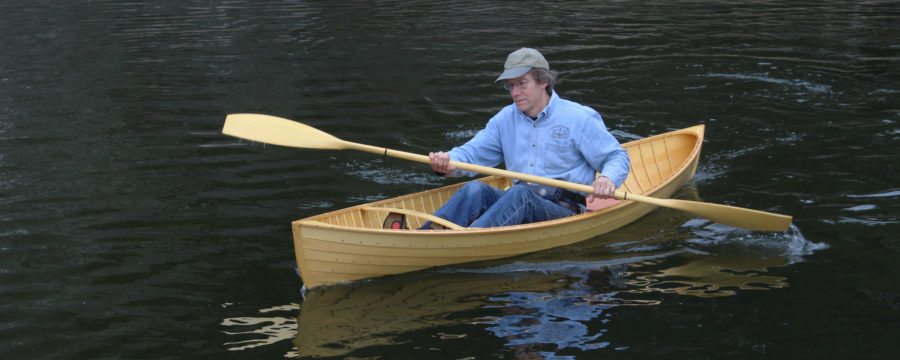
Stickleback Canoe
Oughtred offers a number of options in the plans. The alternate station spacings he suggests can make the canoe 10′ 2″, 10′ 8″ (standard), 11′ 2″, or 11′ 6″. The…
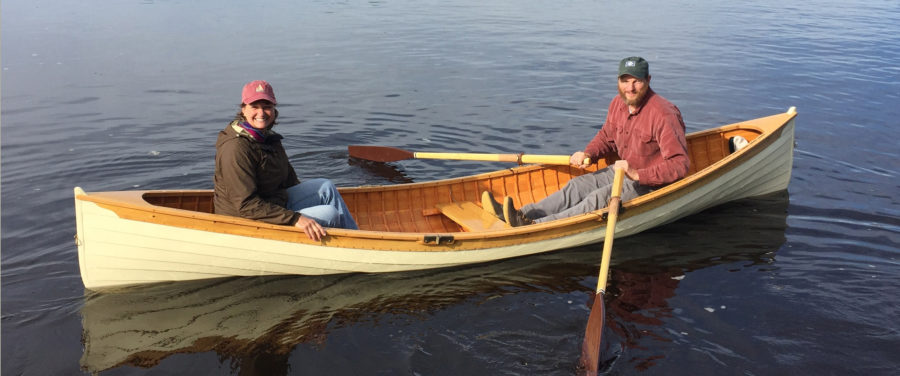
Rushton 109
The Ruston 109 is an old-fashioned guideboat type combining lightness, good looks, and easy rowing. It’s a double-ender with nearly plumb stems, a lapstrake hull, and sweeping sheer. The boat…
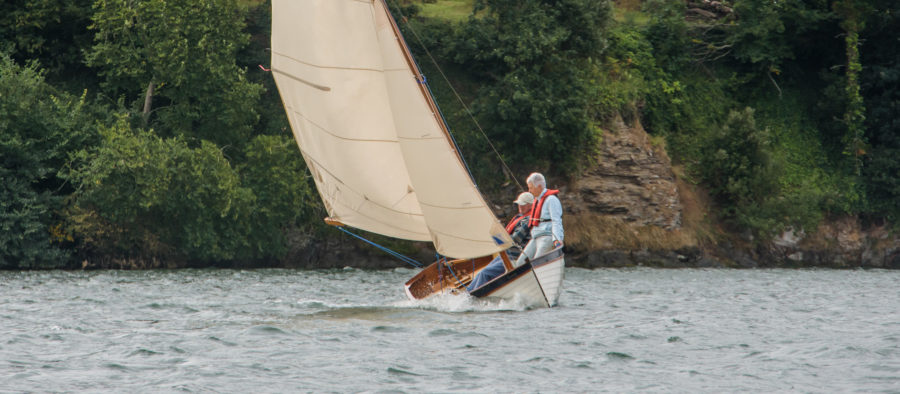
The lines of the Swallow seemed to offer an ideal compromise of lightness, speed, and roominess. The plans are suitable for skilled amateurs, as there are no step-by-step instructions or…

Ruth Wherry
The structure for the Ruth is a combination of plywood and lightweight western red cedar stringers. The 1/2″ marine-plywood stem, frames, and transom are notched for the full-length strips that…

Winter Wren II
I had already built a smaller and simpler Devlin boat, the 13′ 6″ Zephyr daysailer, a project that seemed plenty challenging at the time. The Winter Wren, while employing the…
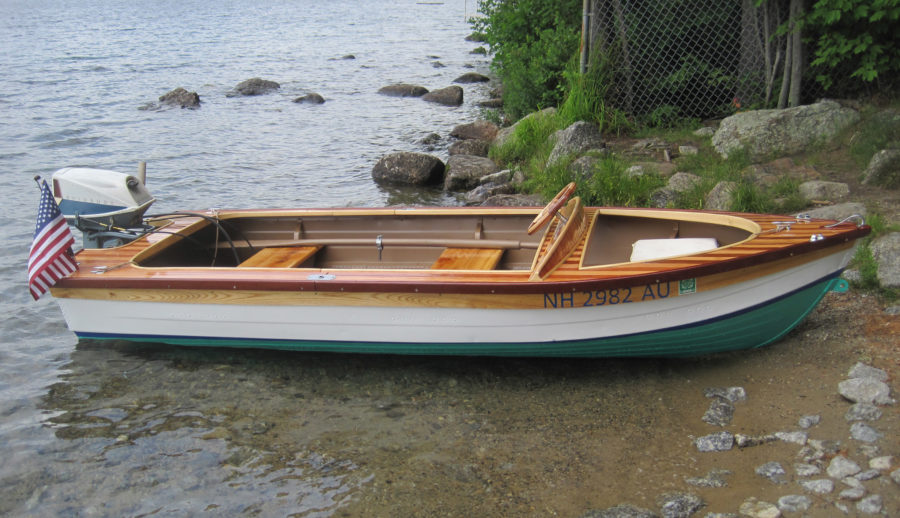
Patrick, approaching retirement and seeing boatbuilding would fill the leisure hours he’d have ahead of him, thought the skiff would be a good winter project and decided to do much…
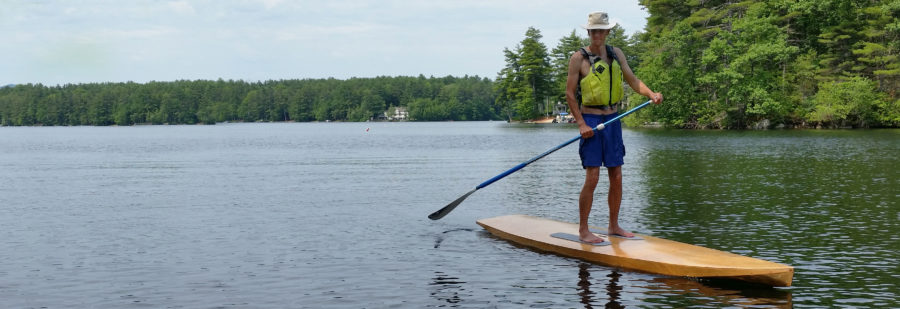
Australian-born designer Michael Storer developed a wooden SUP and named it Taal after a lake near his home in the Philippines. The boats and canoes he designs are light yet…
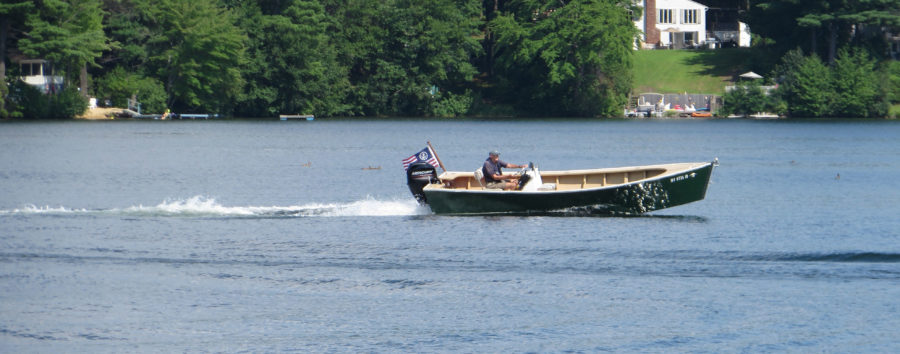
Albion Pacific Power Dory
My trials in a local lake proved that the boat trailered, launched, and performed remarkably well. The bottom is 5′ 9-1/8” at its widest point, and because of the narrow…
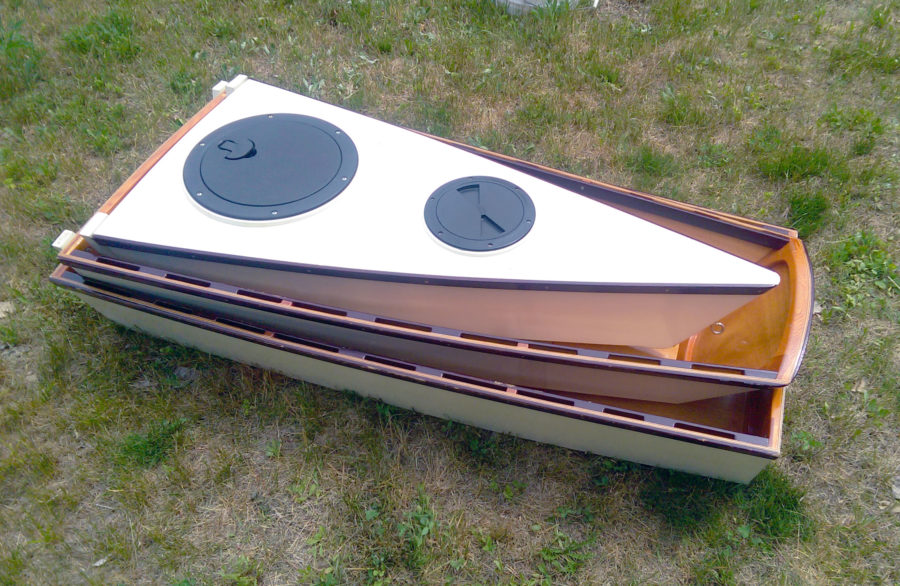
Nesting Boats
Trailering a boat comes with its own set of limitations, and cartopping a boat on his van didn’t appeal to him either, but a nesting sectional boat could go in…
More Boat Profile
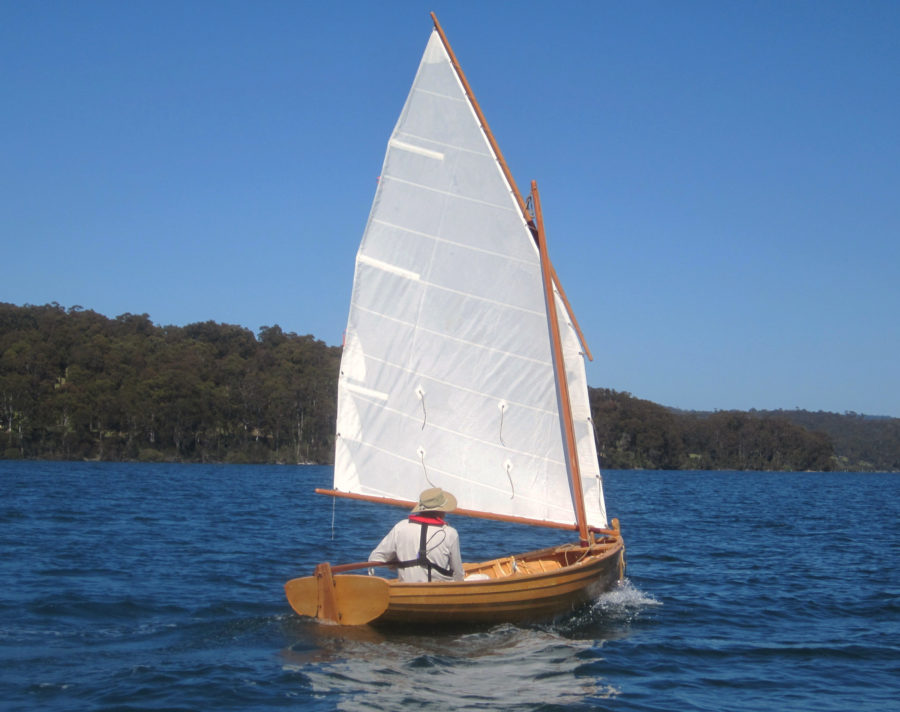
12′ Clinker Dinghy
The six pages of the plan set, available in hard and soft copy, include lines drawings with keel and stem details, offsets, construction drawings with scantlings and fastenings, stem lofting,…
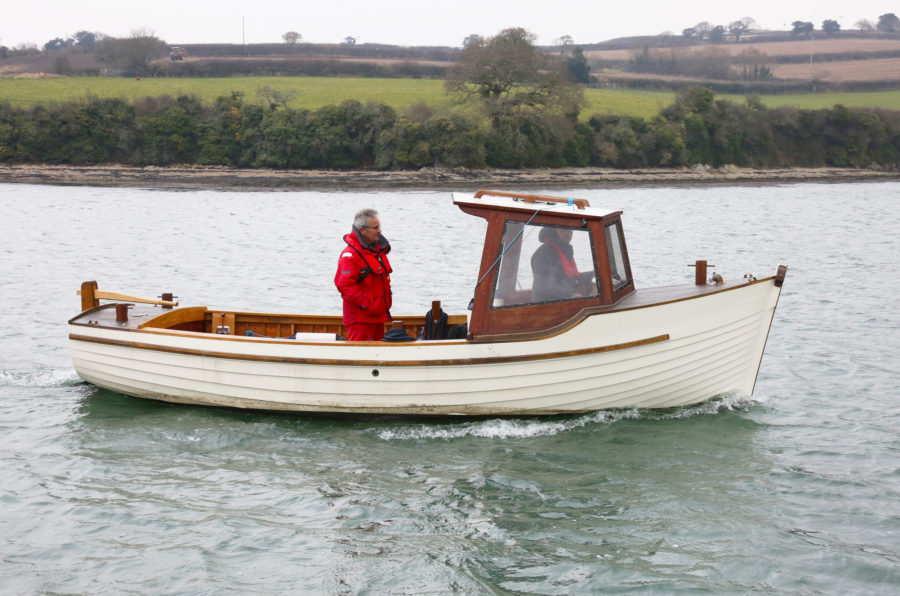
Beer Beach Boat
Alasdair Grant, had built STEADFAST, a 16′5″ version of a 15′3″ Beer Beach boat called WILD DUCK. Beer is a village located in the middle of the Lyme Bay coast,…
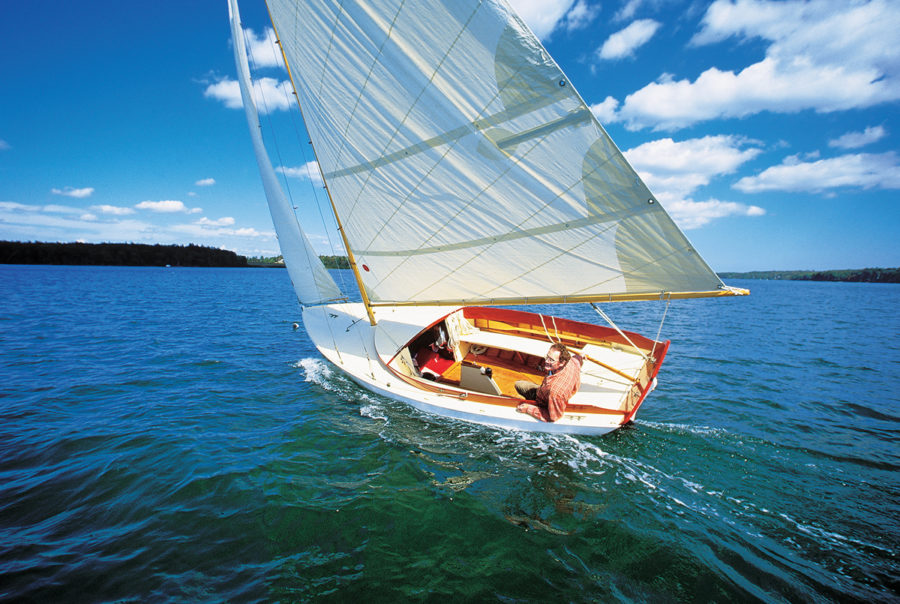
The Flatfish
Every sailor has his own vision of the perfect daysailer. For many, this ideal boat is based on the Herreshoff 12 1⁄2, Nathanael G. Herreshoff’s iconic daysailer, which debuted in…
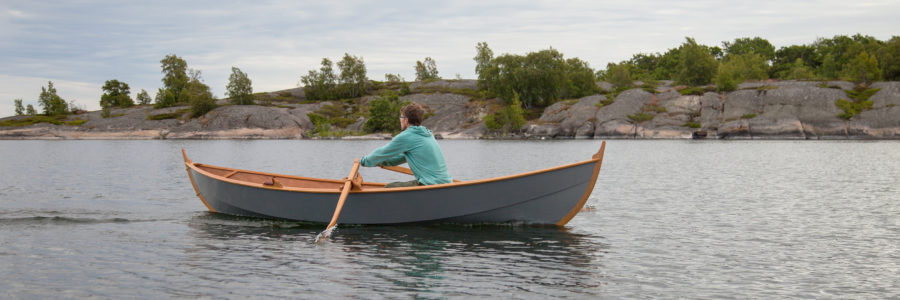
The original faerings were built by hand and eye, and had slowly evolved during hundreds of years to meet the local conditions and particular purposes. Iain carefully studied every design…
Subscribe Today!
Become a subscriber today and you’ll recieve a new issue every month plus unlimited access to our full archive of backlogged issues.
Already a subscriber? Sign In
Subscribe For Full Access
Flipbooks are available to paid subscribers only. Subscribe now or log in for access.
Great choice! Your favorites are temporarily saved for this session. Sign in to save them permanently, access them on any device, and receive relevant alerts.
- Sailboat Guide
1965 O'day Daysailer 17
- Description
Seller's Description
O’day Daysailer 17, 1965 sailboat for sale Solid hull with mast with tabernacle and no boom or sails. Keel and rudder are in place. Gel coat on hull has cracking and needs to be sanded and either painted or gel coat replaced. Good project boat or parts boat. No trailer. Make an offer. Clean title. Brenham, Texas. $500 OBO
Rig and Sails
Auxilary power, accomodations, calculations.
The theoretical maximum speed that a displacement hull can move efficiently through the water is determined by it's waterline length and displacement. It may be unable to reach this speed if the boat is underpowered or heavily loaded, though it may exceed this speed given enough power. Read more.
Classic hull speed formula:
Hull Speed = 1.34 x √LWL
Max Speed/Length ratio = 8.26 ÷ Displacement/Length ratio .311 Hull Speed = Max Speed/Length ratio x √LWL
Sail Area / Displacement Ratio
A measure of the power of the sails relative to the weight of the boat. The higher the number, the higher the performance, but the harder the boat will be to handle. This ratio is a "non-dimensional" value that facilitates comparisons between boats of different types and sizes. Read more.
SA/D = SA ÷ (D ÷ 64) 2/3
- SA : Sail area in square feet, derived by adding the mainsail area to 100% of the foretriangle area (the lateral area above the deck between the mast and the forestay).
- D : Displacement in pounds.
Ballast / Displacement Ratio
A measure of the stability of a boat's hull that suggests how well a monohull will stand up to its sails. The ballast displacement ratio indicates how much of the weight of a boat is placed for maximum stability against capsizing and is an indicator of stiffness and resistance to capsize.
Ballast / Displacement * 100
Displacement / Length Ratio
A measure of the weight of the boat relative to it's length at the waterline. The higher a boat’s D/L ratio, the more easily it will carry a load and the more comfortable its motion will be. The lower a boat's ratio is, the less power it takes to drive the boat to its nominal hull speed or beyond. Read more.
D/L = (D ÷ 2240) ÷ (0.01 x LWL)³
- D: Displacement of the boat in pounds.
- LWL: Waterline length in feet
Comfort Ratio
This ratio assess how quickly and abruptly a boat’s hull reacts to waves in a significant seaway, these being the elements of a boat’s motion most likely to cause seasickness. Read more.
Comfort ratio = D ÷ (.65 x (.7 LWL + .3 LOA) x Beam 1.33 )
- D: Displacement of the boat in pounds
- LOA: Length overall in feet
- Beam: Width of boat at the widest point in feet
Capsize Screening Formula
This formula attempts to indicate whether a given boat might be too wide and light to readily right itself after being overturned in extreme conditions. Read more.
CSV = Beam ÷ ³√(D / 64)
Said to be an adaptation of the CAPE COD KNOCKABOUT. Not to be confused with the OSPREY dinghy, designed by Uffa Fox and built by Fairey Marine in the UK.
This listing is presented by SailingTexas.com . Visit their website for more information or to contact the seller.
View on SailingTexas.com
Embed this page on your own website by copying and pasting this code.
- About Sailboat Guide
©2024 Sea Time Tech, LLC
This site is protected by reCAPTCHA and the Google Privacy Policy and Terms of Service apply.

- Forum Listing
- Marketplace
- Advanced Search
- All Topics Sailing
- Skills & Seamanship
- Learning to Sail
- SailNet is a forum community dedicated to Sailing enthusiasts. Come join the discussion about sailing, modifications, classifieds, troubleshooting, repairs, reviews, maintenance, and more!
1980 CL16 vs 1984 O'Day 17 Daysailer
- Add to quote
Looking to get a used saiboat for a small like in the Berkshires (about a 500 acre lake). I have sailed sunfish, sailfish, and small cats before, but this will be my first real "sailboat", so I need something good for a novice sailer like me to learn and grow with... Want to have two sails (main and jib) and an option for a small outboard for when I don't want to sail but just want to take it out to fish.. Boat will be moored at "dock" at our condo, and want something that is easy to rig, able to sail single-handed, fun in a good breeze for my young adult kids to have fun, but can also fit a few people for a more casual sail if needed. Needs to be fun, but also needs to be able to "right it myself" in case I flip it.. but hopefully not, but you never know.. stuff happens.. and my big boys like to sail "at the edge"... Been looking for used sailboats and came across these two options listed in some local papers.. 1980 CL16 (C&L Boatworks), which seems to be a version of the "Wayfarer" 1984 O'Day 17 Daysailer Thoughts on pros/cons of these two boats for my needs... as long as their condition is reasonable.. prices are similar.. around $2K with a trailer.. Thanks for the help and advice. Michael
I bought a Daysailer last fall. I'm not sure I would recommend it as a beginner's boat unless you can be really mindful of weather conditions when you sail. The boat has all the components of a fractional sloop rig so I wouldn't say its easy to rig. It's no sunfish. It probably takes me twenty minutes to rig if someone is helping. It is not hard to singlehand. It is easy to sail in quiet conditions but can get pretty frisky when the breeze picks up. I have sailed Hobie cats and find them similar. I haven't capsized it yet but the hull is full of flotation, so it shouldn't sink on you. I have mounted a three horse outboard on it and it worked fine. I just don't think its going to be a great fishing boat. 2K seems about twice what you should pay. Sailing isn't rocket science. If you buy this boat you will most likely do fine and not outgrow it. They cost nothing to keep.
I had an O'Day 17 daysailer for about a year. It has a hefty amount of sail area which works great in light air. I would encourage you to put in a single reef above 10 mph winds. I buried the rail many times and never capsized. I never "tried" to capsize it given that I sail in 60 degree (or less) waters on the Oregon coast. If you are in a warmer place, you might "try" to capsize it just to find out what the boat can do. It's fun to sail these and I liked that it had both a kick-up rudder and centerboard. If you sail in shallow waters these would be a must... at least for me. They are well made. As mentioned in the prior post, rigging can take awhile at the launch site. Having two people to get the mast up and set really shortens the setup time. You could leave the side stays and back stay connected while you trailer it. Just have the front stay ready to connect to the bow when you step the mast. Have the boom and mainsheet rigging ready to go. I think I paid about $1800 which included a 40 lb thrust electric motor which moves the boat well. I strapped a battery in the cuddy cabin and always made sure it was fully charged. I don't know anything about the CL16s. I sold it because I wanted to move up to a keel boat. I had no trouble selling it... and got at least what I paid for it. Best wishes in your search.
Thanks for the quick response and the info. on the O'Day. I have a dock at our condo and plan to keep it tied-up to the dock (its shallow, but there are other small sailboats and motorboats at the dock, so shouldn't be an issue if I raise the centerboard). Any issues keeping it in the water with the mast up and semi-rigged on a lake? Hopefully can find a sail cover for the "main" sail and perhaps look to swap-out the regular jib with a rolling jib if they make one that will fit. Any issues? Michael
You may need to rig some kind of bilge pump for rainwater. Maybe a boom tent.
My Daysailer had a plug to drain water collected in the cockpit. And seems I recall also another plug that drained... what? I don't remember.
It's great that you can leave it in the water. As long as you sail it frequently you probably won't get lots of algae growing on the bottom. I trailered mine about a mile but had to do the setup and take down same as if I had to trailer it further. You can find some kind "bag" and leave the jib in the bag on the deck (but hanked on the the forestay) to make it really quick to get out and sail. Or...maybe not in case you are concerned about theft. As for the main, best to find something to cover it, too. Where are you located? If it's in an area where the UV light is intense, for sure get some covers on the sails. I have a Wilderness 21 at a marina. I leave both the main and jib furled on the boat with sail covers. We get lots of rain on the Oregon coast so the covers do double duty all year long.
I was hoping I could get a sailboat cover that would keep the bulk of the rain out.. was presuming they make them for O'Days...
A custom one specifically made for the Daysailer would be pretty spendy. Maybe look for a used one on eBay?
I'm up in the Berkshires of Mass., on a small lake (about 500 acres).. Just looking to go out and have a bit of fun out by myself or with my wife.. or take my parents out for a more "casual" sail... Or even just put-put around with a small outboard for fishing along the shores... M.
einstem said: I'm up in the Berkshires of Mass., on a small lake (about 500 acres).. Just looking to go out and have a bit of fun out by myself or with my wife.. or take my parents out for a more "casual" sail... Or even just put-put around with a small outboard for fishing along the shores... M. Click to expand...
I have sailed both and both are good boats, and both are boats you can grow with. If I was day sailing on a small lake, I might pic the CL16. Its quite a bit lighter to manage on the trailer etc. The DS 17 has a cuddy cabin, which adds considerably to its weight. No problem leaving either boat mast up. Sail cover for the main would be a good idea. You could likely make something.
OK.. Sounds good. And right now, it is looking like the CL16 may be in better shape so I may look at that one first. From what I read about it, it is a Canadian built version of the Wayfarer, and looks pretty nice.. Here is a link to the CL16 site: C&L Boatworks CL16 Page Looks like what I am looking for.. M.
We are on Lake Pontoosuc.. on the north side of Pittsfield and south side of Lanesboro.. About a 500 acre lake and pretty "round" which should make it good for sailboating.. although it gets pretty busy on the weekends from the power boaters.. Michael
- ?
- 175.5K members
Top Contributors this Month
Home > Find Your Sail > Search by Make and Model > O’Day > O’Day 17

O’Day 17
" * " indicates required fields
Step 1 of 3
Let's Get to Know Each Other
Let's connect, why it's important to partner with a designer on your o’day 17 sail.
The design is the most critical part of your new sail. Ensuring the sail fits and performs its best is a must for our crew. The Precision Sails Design team are experts at their craft. Unlike other sail lofts all of our sailors work one-on-one with a designer to perfect their O’Day 17 sail.
No Two O’Day 17 Sails Are Alike
There are many factors that affect the performance and design of your sails. Location, sailing experience, and weather conditions all come into play when picking the perfect sail. Two mainsails made for two O’Day 17’s in California and Florida will have different designs, sailcloth, and options based on what is best for the sailor.
Taking measurements is easy. All sailors work alongside our measurement team to measure and confirm their rig specs. This helps ensure your design is flawless and allows us to extend our Perfect Fit Guarantee to all of our sailors.
Discover the best cloth for your sailing needs, our sail details, or more about how Precision Sails is leading the sail-making industry with innovative new practices.

Proudly offering the largest selection of sailcloth in the industry, our team is always available to help you find your perfect sail. Whether you're a weekend sailor, coastal cruiser, or club racer our team is ready to walk you through the process.
Types of Sails
Precision Sail Loft specializes in producing headsails, mainsails, spinnakers, gennakers, and code zeros. So no matter the type of sail you’re looking for, we can help. Our sails are trusted by cruisers and racers alike from around the globe. Review the sail options and craftsmanship available to customize your dream sail.
Build & Process
Every sail we craft is produced to the highest standards with the best hardware, craftsmanship, and skill-set in the industry. Pair that with Precision Sails' approach to communication and your sailboat will be ready to set sail before you know it.
Unparalleled Commitment To Helping Sailors
As experts in design, communication, and production our team is ready to take on the task of making sails for your boat. Give us a call to get started.
“ I just received my asymmetrical spinnaker, with sock and turtle bag, along with a new 135 Genoa. The entire process was simple and both sales and the design team were in regular contact if there were any questions. The customer portal was easy to use and lets you keep track of where in the process your sails are. Great sails, great service -Graham Edwards (Facebook)
“ The whole team at Precision Sails was fantastic from start to finish. We’ve had a laminate main and genoa made so far and have a spinnaker on the way. They listened carefully to our needs and recommended a great sail cloth. We couldn’t have gotten more bang for our buck! -Noah Regelous (Google)
“ We received our spinnaker and launched it yesterday and I just wanted to let you know how pleased we are with it. The service we received from your company was exceptional and the quality of your product is second to none. We will certainly be return customers in the next few months to replace our main and jib sails and will recommend your company to all our sailing buddies. Once again-thank you.” -Daniel Jackson (Google)
“ we had good communication during the planning stages and the knowledgeable people at precision sails really got me fixed up good! The sails look and work fabulous! my boat sails better than it ever had! couldn’t be more pleased with the product AND the service!” -Fred Jelich (Facebook)
“ Our new furling jib for a Corsair 27 Had to be specially designed due to the height of the furler, but this was accomplished quickly and in short order we had our sail which fits beautifully and has a great shape. It’s everything we could have wanted, high tech design, thoughtfully executed and affordable.” -Nancy Y. (Yelp)
Request a O’Day 17 Quote
Looking to buy a new headsail or mainsail for your O’Day 17? Request a free quote from Precision Sails for a new custom sail. Our team will work with you to design the perfect sail for you.
Thanks for telling us a bit about yourself and your boat. Our team will send you a preliminary quote based on information we have gathered from sailors similar to you.
We will give you a call in order to narrow down the options on your quote and improve the accuracy. If you want us to call you at a specific time, feel free to schedule a time on our calendar!
Thanks for telling us a bit about yourself and your boat. Our team will reach out to offer some suggestions and get started on finding you the perfect sail!








IMAGES
VIDEO
COMMENTS
The DAYSAILER was a collaboration of Uffa Fox & George O'Day. Fox designed the hull, but the original cuddy was designed & molded by O'Day & his company. The DAY SAILER has been built by several builders and with a number of changes along the way but the basic hull design has remained the same. The DAY SAILER II was introduced in 1971 as an ...
A proven performer for 61 years. Written by Kent and Audrey Lewis. From Issue Small Boats Annual 2020 July 2019. The production of small boats was booming in the 1950s on both sides of the Atlantic, and really took off in the late '50s with the introduction of fiberglass. Famed designers Uffa Fox and George O'Day teamed up in 1956 to create ...
Founded by famed Americas Cup sailor and olympic medalist George O'Day. In the beginning George O'Day Associates was only a distributor for several brands of small Sailboats. Some were produced by Fairey Marine of England and Marscot Plastics in the USA. (O'Day took over Marscot in 1958 to build the RHODES 19.) Soon he became involved in producing his own line of boats. Among the most ...
The best way to learn is to do it and a small daysailer is the absolute best way to gain experience with out too many liabilities. After he's thoroughly comfortable in the O'day 17, let him sail the 37'. As far as driving, the more kids in a car, the crazier they act. With the O'day, can't get too crazy. To save money, you might want to be sure ...
ODAY preowned sailboats for sale by owner. ODAY used sailboats for sale by owner. Home. Register & Post. View All Sailboats. Search. ... Sailboat Added 17-Sep-2023 More Details: O'Day 272: Length: 27' Beam: 9' Draft: 3' Year: 1987: Type: cruiser: Hull: fiberglass monohull: Engine: gas outboard;
The Day Sailer is a One-Design 17 foot Sailboat designed by Uffa Fox and George O'Day in the late 1950's. Over 10,000 Boats have been built. The Day Sailer was inducted into the American Sailboat...
Find O-day boats for sale in your area & across the world on YachtWorld. Offering the best selection of o-day boats to choose from. ... 1988 O'Day 322. US$18,900. Sailboats Northeast | Marblehead, Massachusetts. Request Info; Price Drop; 1977 O'Day 32. US$9,900. ↓ Price Drop. McCotters Marina | Washington, North Carolina.
1993. 17'. '. '. Florida. $3,400. Description: For Sale Classic 17ft ODay daysailer - with trailer, custom rowing oars, and with or without optional Torqeedo electric outboard motor. $3,400 boat, w/trailer, and oars (plus $700 more for optional Torqeedo motor & battery)
O'day Daysailer 17, 1965 sailboat for sale Solid hull with mast with tabernacle and no boom or sails. Keel and rudder are in place. Gel coat on hull has cracking and needs to be sanded and either painted or gel coat replaced. Good project boat or parts boat. No trailer.
Offering the best selection of o-day boats to choose from. ... Clear Filter Make / Model: All O'Day Category: Sail - Daysailer. Location. By Radius. By Country. country-all. All Countries. Country-US. United States. All. All 25 miles 50 miles 100 miles 200 miles 300 miles 500 miles 1000 miles 2000 miles 5000 miles.
Oday Day Sailer Wareham, MA. Jul 27, 2015. #3. As Brian S mentioned, I have an expanded version of the Original DS II Manual that I have made available to other owners (unfortunately, cost is $20 for printing and postage). Here is the diagram of the main and jib sheets assuming your boat is pre-1975 (picture is small, but looks to be of that era).
Oday Daysailer Sailboat pictures, a collection of Oday Daysailer sailboats with specifications and photos. Oday Daysailer Sailboat Photo Gallery. Home: Lessons: Rentals: How To: ... O'day Daysailer 17, 1965, Brenham, Texas, $500 4/16/14, 1965 Oday Daysailer 17, Lancaster Pennsylvania, $1,900 4/5/12, 1965 Oday 17, Pittsburgh, Pennsylvania, $1,400:
ODay preowned sailboats for sale by owner. ODay used sailboats for sale by owner. Home. Register & Post. View All Sailboats. Search. ... Featured Sailboat Added 17-May-2024 More Details: O'Day 39 Jeanneau Sun Fizz: Length: 39' Beam: 12.58' Draft: 5'6' Year: 1984: Type: racer/cruiser: Hull:
1980 CL16 vs 1984 O'Day 17 Daysailer. Looking to get a used saiboat for a small like in the Berkshires (about a 500 acre lake). I have sailed sunfish, sailfish, and small cats before, but this will be my first real "sailboat", so I need something good for a novice sailer like me to learn and grow with...
Unlike other sail lofts all of our sailors work one-on-one with a designer to perfect their O'Day 17 sail. Learn About Sail Design. Video Content Not Supported. No Two O'Day 17 Sails Are Alike. There are many factors that affect the performance and design of your sails. Location, sailing experience, and weather conditions all come into play ...
Oday 17 Daysailer II, 1981, Jacksonville Beach, Florida, $3,600, price reduced 8/6/07 to $3,200, ad expired ... Texas Lakes: Advertise with us: Contact: Free Sailboat Ad: Go to Sailing Texas classifieds for current sailboats for sale . 1981 Oday 17 Daysailer II 17' LOA 6'3" BEAM 3'9" DRAFT (keel down) Swing Keel Hinged Mast New Laminated Wood ...
1993 O'Day classic 17 Daysailor sailboat for sale in Florida. For Sale Classic 17ft ODay daysailer - with trailer, custom rowing oars, and with or without optional Torqeedo electric outboard motor $3,400 boat,... Florida. $ 3.400 $ 3.400. Detailed View.
19' Flying Scot Flying Scot 19 Sailboat Lake Fairview Marina Orlando, Florida Asking $31,500
Find 24 O'Day boats for sale near you, including boat prices, photos, and more. Locate O'Day boat dealers and find your boat at Boat Trader!
If you didn't buy the boat new perhaps the previous owner used a different sail (non O'Day) or had the sail recut thereby loosing some luff length. ... (I've owned and raced 3), and the boom is high for a 17 footer. Your old sail has a very strange foot shape, too. I've attached the DS1 assembly instructions from O'Day, and part 3 of the class ...
Find many great new & used options and get the best deals for 1979 O'Day Center Cockpit 37' Sailboat - 2004 Yanmar Diesel Runs - California at the best online prices at eBay! Free shipping for many products! ... The vehicle didn't have a 17-digit vehicle identification number. The vehicle wasn't intended for the US market (such as limited ...